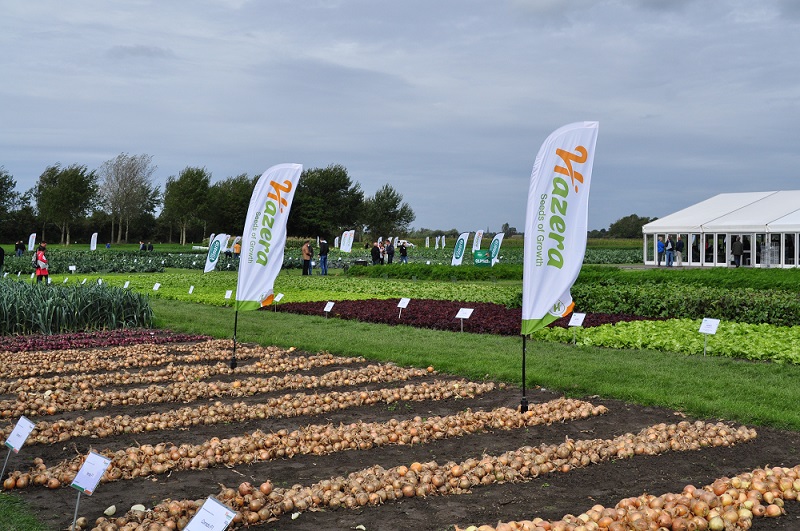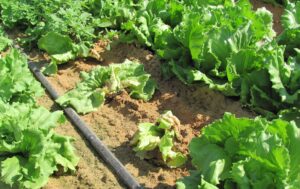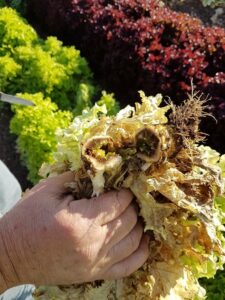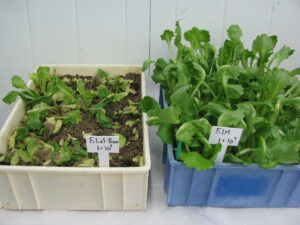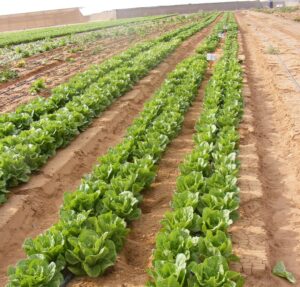Dr. Yaniv Rotem – Solanaceae Pathologist, Hazera Co.
General Background
The fusarium disease in lettuce is a deadly wilt and collapse disease that is caused by the fungus Fusarium oxysporum f. sp. lactucae.
The disease was first discovered in Japan in 1955 and has since spread to other countries around the world. Today, there are three known races of the fungus – races 1, 2 and 3.
Starting in 2008, we began encountering the phenomena of wilting and collapse in Israel, in the Besor region and other growing areas. The first identification of fusarium as a cause of wilting and collapse was made in 2009 in Hazera’s phytopathology laboratory, when the fungus F. oxysporum f. sp. lactucae was clearly identified through isolation from infected plants and through the performance of the Koch test. As part of the initial phase of our research work, it was also clearly defined that the fungus found in Israel is of Race 1.
Fusarium disease is particularly severe in summer, but over the years the intensity of the disease has increased in Israel and more and more affected fields are being seen, even in winter.
Symptoms of the Disease
Overall, the symptoms of the disease are similar to wilt diseases caused by fusarium in many other crops:
- The first symptom of the onset of the disease is the appearance of yellowing in the leaves.
- At a slightly later stage, we observe a loss of turgor of the plant, necrosis in the leaves, and finally, collapse of the entire plant.
- When the root and stem of a lettuce plant affected by fusarium are cut, we see a characteristic red-brown color (internal browning).
Images 1, 2: Yellowing of leaves and collapse of lettuce plants in an infected field in the Besor region.
Image 3: Typical internal browning of the lettuce plant stem when damaged by fusarium.
Image 4: Performing the Koch test in the laboratory: On the left – lettuce seedlings infected with fusarium isolate that was isolated from an infected plant brought from the field, in which symptoms and collapse similar to those observed in the field can be seen. On the right – lettuce seedlings infected for comparison purposes with melon fusarium isolate (F. oxysporum f. sp. melonis), in which no damage is visible.
How Is the Disease Transmitted?
- The disease is caused by a fungus that survives in the soil, mainly in the form of resting spores (chlamydospores) with thick walls that can survive in the soil for many years. When lettuce plants are planted in soil containing these chlamydospores – the mycelium regenerates from them, penetrates the roots of the developing plant, and enters the vascular system in the roots and stem.
- During the season, the fungus is able to move underground from an infected plant to a healthy neighboring plant by moving between roots that are touching each other.
- The fungus is able to spread in the field via water moving through the soil as well as on the equipment used to work the soil. Vehicles and agricultural equipment that are moved from field to field – enable the disease to be spread from an infected field to distant healthy fields.
Development of Fusarium-Resistant Lettuce Varieties
- In the first stage – a number of preliminary experiments were conducted in which the exact method for infecting lettuce seedlings with fusarium was determined in a way that ensures the correct distinction between plants that are susceptible and plants that are resistant to the disease. The method developed enables laboratory testing of a large number of lettuce lines, identification of the resistant lines, and selection of the most resistant plants in order to progress to the next generation.
- After that, hundreds of lettuce lines were screened in the laboratory in a series of experiments, and the most resistant lines among them were identified.
- Concurrently with the laboratory work, experiments were conducted in an infected area in the Besor region. Comparison between the results of the laboratory experiments and of the field experiments showed a high correlation between the two methods.
- In 2013 Hazera launched the first leaf lettuce variety that combines fusarium resistance with good quality – Asaf.
- In the years that followed, Hazera developed additional resistant varieties: Raviv – a summer romaine, Ishtar – our senior winter romaine, Dikla – a romaine with hearts that are convenient for packing, Lior – a romaine with a large number of inner leaves, and also, Solo Mio – our crunchy iceberg lettuce.
For more information about Hazera’s lettuce varieties, click here.
Image 5: A resistant variety in comparison with a sensitive variety, in the cultivation area in the Besor region.
Image 6: Asaf – a fusarium-resistant variety by Hazera, in an infected area in the Besor region


